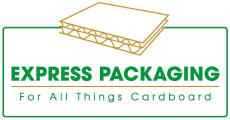Boxes exist in all corners of the globe and in almost every person in all walks of life in some form or another. Boxes hold and transport products in stores and warehouses. They are used to effectively store things in people’s homes and businesses. They are almost always used to help people move from one home to another. Yet despite this role in so many people’s lives, the boxes that are all around us are often taken for granted. Many people have no idea where the boxes they use every day come from or how they are manufactured. The most commonly used boxes are regular slotted cartons (RSC). These boxes come in an enormous variety of shapes and sizes and the process they undergo during manufacture is very interesting.
RSC Boxes begin life as Plain Cardboard
All RSC Cardboard Boxes begin life as plain, unconverted cardboard sheets. Cardboard consists of three main parts; Firstly, there is the flute. That is a piece of cardboard that has been folded repeatedly to form pleats. Two other pieces of cardboard paper are then carefully glued to the two sides of the flute. The end result is a strong and reinforced paper sheet of what is then known as corrugated cardboard. These pieces are basic flat sheets that can come in an almost endless variety of widths and lengths as well as a huge range of shapes and sizes.
The strength of the cardboard that is being manufactured can also vary enormously. This variation occurs depending on the varying levels of thickness of the paper that is combined and used to make up the various elements of papers and the flute. As a general rule, the thicker the paper being used, the stronger the overall cardboard will eventually be. Once this plain and unconverted corrugated cardboard sheet is made, it is then ready to be converted into a regular slotted carton.
Turning Cardboard into Cardboard Boxes
A reputable carton manufacturer can manufacture boxes of almost any shape and size based on the needs of their customers. Most manufacturers will have a range of standard sized boxes, but businesses who manufacture in house using the latest technology such as Express Packaging are also able to custom design and manufacture cartons specifically to meet the individual needs of their customers. The customer provides the dimensions and specifications and the shapes needed for their custom RSC boxes and the manufacturer then sets up the die to complete the task.
The sheets of raw cardboard that were created will now be cut into the correct size and shape and will usually have additional cuts made to allow for folding the cardboard and creating the flaps in the correct places. The cardboard is generally initially a flat sheet until it is then folded together. There are usually two flaps on the top and the bottom of the cardboard sheet that will typically meet in the middle to form the top and bottom components of the box. These flaps can then be moved to the next stage of the process where they can be sealed with glue or tape to complete the box.
Once the custom RSC boxes have completed this process they are then ready to either be shipped to the customer directly or they can in some cases have custom graphics added to them depending on the wishes of the individual customer. The graphics can include any information that the customer thinks is important and this is often a highly effective way to promote a brand when the product is out in the marketplace.
Once the customer has finished using these boxes and they have completed their purpose, a terrific feature of most corrugated cardboard cartons and custom RSC boxes is that they can then be easily reused for other purposes such as storage and they are also able to be recycled and begin life as another carton down the line, making this an excellent option for the environment and businesses and individuals who are attempting to operate in a sustainable and environmentally conscious way.
Contact US at Express Packaging and see if we can help you to design the perfect custom RSC box for your business. You can even visit us at our offices and factory in Emu Plains in Sydney’s West and see your boxes in production for yourself!
